Svendborg,Denmark 作者: 来源: 发布时间:2021-09-29
一、人口,面积,所属地区
Population: 58,296
Area: 417 km²
Municipality in Syddanmark
二、自然地理
Svendborg municipality is a municipality in Region of Southern Denmark on the southeast coast of the island of Funen, as well as on the islands of Drejø, Hjortø, Skarø, Thurø, and Tåsinge off Funen's southeastern shores in south-central Denmark. The main town and the site of its municipal council is the city of Svendborg.
South of the municipality separating that part located on Funen from the other islands is Svendborg Strait. The 1,220-meter long Svendborgsund Bridge connects the municipality at the city of Svendborg over the islands of Tåsinge and Siø, where the 774 meter long Langeland's Bridge continues to the city of Rudkøbing on the island of Langeland. The Svendborgsund Bridge was opened in 1966. The Langeland's Bridge was opened in 1962, and is Denmark's 10th longest bridge.
Svendborg is a town on the island of Funen in south-central Denmark, and the seat of Svendborg Municipality. In 2000 Svendborg was declared "Town of the year" in Denmark, and in 2003 it celebrated its 750th anniversary as a market town. By road, Svendborg is located 195 kilometres (121 mi) southwest of Copenhagen, 183 kilometres (114 mi) south of Aarhus, 44.2 kilometres (27.5 mi) south of Odense, and 28.5 kilometres (17.7 mi) south-southeast of Faaborg.
To the west of Svendborg are several lakes, including Sørup Lake (Sørup Sø), 3.8 kilometres (2.4 mi) northwest of the centre, and Hvidkilde Lake (Hvidkilde Sø), 5.8 kilometres (3.6 mi) northwest of the centre of Svendborg. Several forested areas lie to the north-northwest of Svendborg, including Græsholmene, Løvehave, and Ravnebjerg Skov.
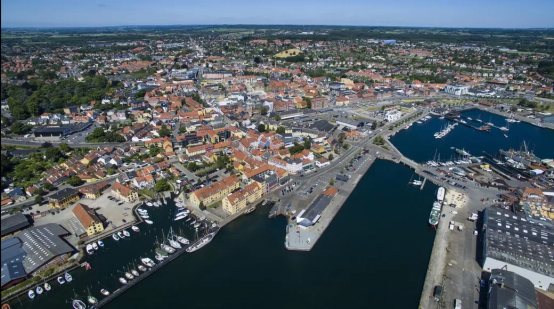
Transport
Ferry service connects the municipality at the town of Svendborg to the municipality's islands of Skarø, Drejø, and Hjortø, and to the town of Ærøskøbing on the island of Ærø.
The Port of Svendborg is accessed by several channels, feeding through the islands of Tåsinge and Thurø. Svendborg Sund approaches the town from the southwest, along which ferries coming from Ærøskøbing pass the smaller islands of Drejø, Hjortø, and Skarø. Between Tåsinge and Thurø is Thurø Sund, which passes Bregninge forest (Bregninge Skov) on the northeast coast of Tåsinge, approaching the port of Svendborg from the south. From the east, between mainland Funen and the island of Thurø, is the narrow Skårupøre Sund.
三、经济发展和规模
Looking back on the year 2018, there are some cases that again drew lots of headlines. Wind turbines and solar cells, urban development projects, the square and various local plans always fill a lot. By far, the largest part is about municipal welfare benefits for the 58,599 citizens living in the municipality.
By the beginning of the year, municipal welfare services were under intense pressure. The City Council therefore faced a very difficult task. To ensure long-term balance in the municipality's budget, budget improvements of approx. 100 million This is due to several factors. First, the former City Council had postponed a savings requirement of DKK 50 million. In addition, the municipal co-financing of hospital expenses increased far more than anticipated. At the same time, the promised countervailing reform was postponed. These conditions meant that the municipality's cash balance was very low.
In the spring, the City Council agrees on a partial settlement with reductions of just over DKK 70 million. DKK, and reached the target at the final budget settlement.
2018 was the year in which Better Balance II was published, which resulted in 2 offices of the Danish Agency for Research and Education with approx. 50 employees are located in Svendborg. And the SKAT is strengthened, which means that Svendborg's existing tax department is retained and gets more employees. The new center will be a combined customer and case management center for property assessments and will comprise approx. 200 taxpayers when fully implemented.
In general, 2018 for the Municipality of Svendborg ended with an incredibly low unemployment rate of only 4%, a house price level above the average in the Region of Southern Denmark and a slight decline in the number of inhabitants.
In 2018, focus on the older life of the future - senior housing, establishment of Unesco-Geopark with fantastic perspectives for Svendborg and the tourism of southern Funen, continued development of the port of Svendborg, support for the realization of a new SIMAC as the focal point of a maritime power center on Nordre Kaj and hosting the upcoming DGI National Conference in 2021. The municipality's property in Bagergade is empty, and the City Council has decided that the property must be offered for sale. Building can be used for a variety of purposes - such as. senior housing.
Svendborg Municipality, despite a slender cash portfolio and efficiency requirements in the million class, can present an accounting result for ordinary operations with a nice operating profit of DKK 171.4 million. - the budget said DKK 114.5 million The municipality's net construction costs landed at DKK 95.0 million. DKK, with deferred net investment of DKK 53.9 million DKK 2019 for 2019. These results, together with the financial items, show a strengthened liquidity of DKK 0.4 million. DKK in 2018.
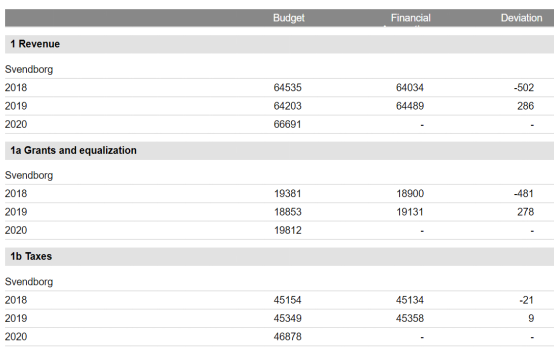
*All amounts are in DKK per. per capita in current prices.
四、产业特点重点项目
Goal of Commerce development
In 2022, targeted efforts have led to a significant increase better knowledge of Svendborg's business strongholds.
Support the green transition in business life in favor of corporate competition ability and future generations.
Svendborg's business community is supported for growth through active and committed networks and collaborations worker
The largest container ship company in the world, A.P. Møller-Mærsk has its origins in Svendborg, in the "Villa Anna". The company remained in the hands of Mærsk Mc-Kinney Møller until his death in 2012 at the age of 98.
The Mac Baren tobacco factory was established in Svendborg in 1887, under the name Harald Halberg Tobaks and Cigarfabrik. The company was renamed the Mac Baren Tobacco Company in 1995. The company employs 140 people, and exports tobacco products to 70 countries.
The Innovative Energy Saving Project
Since June 2012, the Municipality of Svendborg has been working on an innovative energy saving project as a model for the future activity in the energy area.
The innovative energy saving project includes an innovative think tank, which is a creative forum where a wide range of stakeholders can invite both tried and tested ideas and projects that can promote and qualify the work of developing innovative energy saving projects and solutions in the municipality of Svendborg .
Energy saving project will run over six years and, in addition to the preparation of an optimization catalog with input from the innovative think tank, also includes energy labeling of the entire building stock as well as investment in the building stock.
The GO2Green association acts as a close partner in the innovative energy saving project.
五、风景名胜,景点
Alexander Park at Valdemars Castle
Address: Slots 100, 5700 Svendborg
The park at Valdemar Castle is a beautiful landscape park with wide lawns and stately old tall trees. At the southern end of the park, below the church staircase, is a small garden with roof hedges and a water basin. This small garden still appears as a beautiful version of a garden shape that was common at the beginning of the last century. The lawns of the park all slope down to the impressive and very eye-catching lake, which is so beautiful with the forest as an absolutely magnificent backdrop. In 1823, Pastor Lund writes that the area bears the name "The Lake" and that it was contained around 1700 by Knud Juel, son of the sea hero Niels Juels. The history of the lake dates back to the mid-1600s, when it was first mentioned. Tarp writes that Valdemar's Castle was built on a small country tongue with a cove that went south and west of it,
For many years, the "lake" lay as a low moist meadow area with grass, just as it was occasionally cultivated with, for example. rape. In 2003, extensive restructuring was carried out, which among other things changed the drainage conditions, with the result that the area today appears as a large flat-water lake for the immense benefit and enjoyment of waterfowl life, which has flourished to the highest degree, and for the viewers who can enjoy this magnificent sight.
The park is named after Alexander who is the 12th generation after the heroine Niels Juel and son of Caroline Flemming.
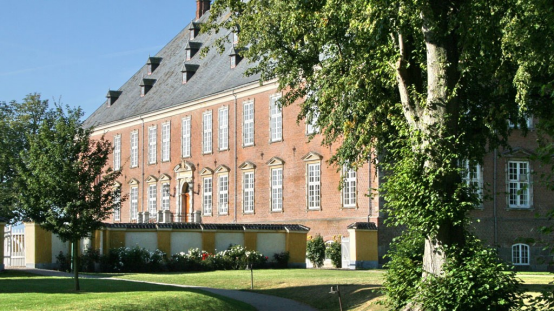
The country Cemetery
Address: Elvira Madigans Road 39, 5700 Svendborg
The country Cemetery has tombs for 2 English airmen from WWII, but is especially visited due to the tomb of Elvira Madigan and Count Sixten Sparre.
Circus artist Hedvig Jensen with the artist name Elvira Madigan (22 years) fled in 1889 from Stockholm to Svendborg with his beloved - the Swedish dragon lieutenant.
Here they lived on a "honeymoon" until the 3 weeks later killed themselves in the Nørreskoven at Valdemars Castle because Sixten Sparre was married and they could not get each other.
PE Møller-Petersen has written the book "Elvira Madigan" and the Folkemindesamling at Tåsinge Skipperhjem, Bregninge contains memories of the drama.
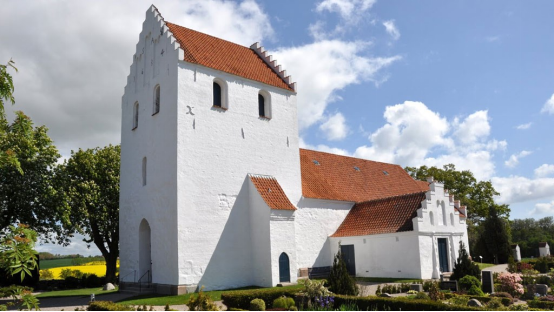
六、历史文化
Early history
In the light of archaeological discoveries, Svendborg appears to have been established in the first half of the 12th century or even earlier. Located at the head of a bay, the natural harbour encouraged seafaring and trade.
The first recorded mention of Svendborg occurred in 1229 in a deed of gift by Valdemar the Victorious, where he refers to the fortification as Swinæburgh. The name is thought to consist of the elements "svin" meaning "pig" and "borg" meaning "fortification". In 1236, the Greyfriars monastery in Svendborg was established. The Greyfriars would be part of the city for the next 300 years, until the Protestant reformation in 1536. The ruins of the monastery were partly excavated beside the railway in 2007.
Middle Ages
In 1253, the city was granted market town privileges by King Christopher I. In the Middle Ages, the city was fortified with walls and moats. The defense system also included a few of forts. Most historical facts about the medieval defense system, including the locations of fortifications, are disputed, as little archaeological evidence has been generated. In spite of this, it is a popular theory that the three towers in the coat of arms are the three fortifications ("Skattertårnet", "Kyseborg" and a third one unnamed). Thanks to its seafarers, in the late Middle Ages Svendborg became one of the most important trading centres in Scandinavia.
16th and 17th centuries
During the time of the Protestant reformation and the Count's Feud in the 1530s, the citizens of Svendborg joined forces with the King. Ørkild Castle, located just east of Svendborg, was property of the bishop of Odense, who was less than popular among the citizens of the city. The tension resulted in the castle being seized and burned down by an angry mob in collaboration with the King's forces. The King's forces would later, after ending their north-going campaign on Funen, return to pillage and plunder Svendborg.
After 1536, Svendborg went through a brief period of progress becoming the islands main port. But it would not last for long. In the following 250 years, the city faced various setbacks in its development, such as plague, a major fire, and the effects of the Swedish wars when Svendborg's ships were destroyed.
Industrial development
It was not until the end of the war with England and the Industrial Revolution in the early 19th century that the city returned to a period of increasing prosperity. The population grew from a mere 1,942 people in 1801 to more than 11,500 in 1901. This development was followed by improvement of the infrastructure, such as rail links with Odense, Faaborg and Nyborg, improvement of the local roads and the establishment of a real harbour suited for extensive trading, since goods could now easily be transported there. In the middle of the 19th century an explosion of industrialization happened, and all kinds of factories, from engineering to breweries were established together with modern gas and water systems.
In the late 19th century, with industry well established, it was necessary to accommodate the growing population. This led to numerous new schools being founded. Furthermore, a hospital was established in 1871 and expanded in 1891.
20th century to present
The rapid increase in population continued at the beginning of the 20th century as Svendborg developed into an even more important industrial and educational centre. The food and metallurgy sectors became well established. The port prospered with new facilities, including shipyards such as Svendborg Skipsværft which was established in 1907 on an artificial island. On the educational front, a number of maritime and navigational schools were established. The shipyard, which had employed up to 800 in the 1980s finally closed in 2001, some of the facilities being taken over by Vestas. In recent years, there has been a marked transition from industry into the service sector, the hospital now being one of the principal employers. Tourism has also prospered, especially for those arriving in pleasure boats.
The German writer Bertolt Brecht spent the first years of his exile from Nazi Germany in Svendborg. The town provided the title of a collection of Brecht's poems "Svendborger Gedichte" (Svendborg Poems).
On 1 January 2007 Svendborg municipality was, as the result of Kommunalreformen ("The Municipal Reform" of 2007), merged with Gudme and Egebjerg municipalities to form an enlarged Svendborg municipality.
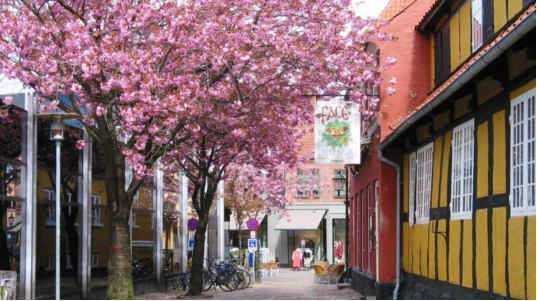
七、联系方式
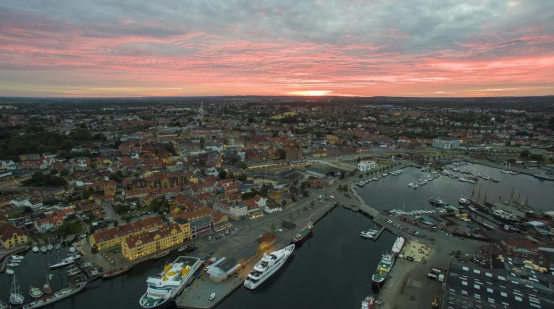
Mayor: Erik Meldgård Bendorf
Address: Ramsherred 5, 5700 Svendborg
Telephone: 62 23 30 00
Facebook: https://www.facebook.com/Svendborg
Website: https://www.svendborg.dk/
Office Hours:
Monday-Tuesday : 9-13
Wednesday : Closed
Thursday : 9-13 and 14: 45-16: 45
Friday : 9-13
